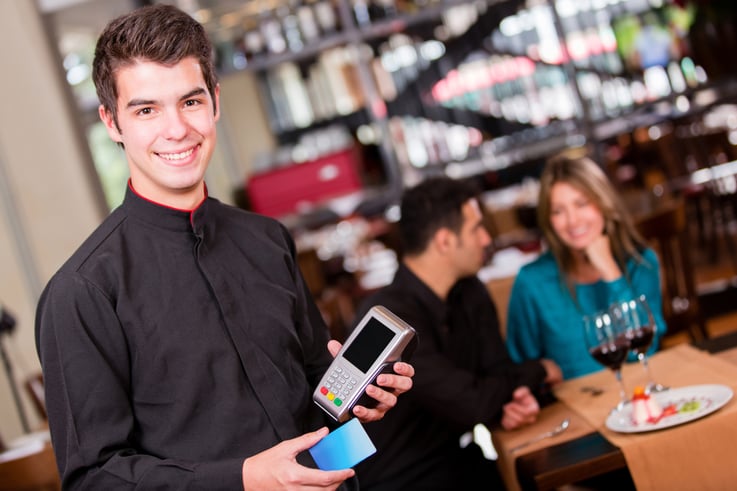 For many restaurants faced with onsite dining lockdowns during the pandemic, adapt or die became their strategy for survival. Today, that philosophy appears to have paid off as changes in consumer behavior, new technology, and restaurant design transformed the restaurant industry. Revenue projections are optimistic, with a National Restaurant Association survey estimating restaurant sales will hit nearly $900 billion this year, up from approximately $800 billion in 2021. Here are some changes implemented during the pandemic that are still popular today.
For many restaurants faced with onsite dining lockdowns during the pandemic, adapt or die became their strategy for survival. Today, that philosophy appears to have paid off as changes in consumer behavior, new technology, and restaurant design transformed the restaurant industry. Revenue projections are optimistic, with a National Restaurant Association survey estimating restaurant sales will hit nearly $900 billion this year, up from approximately $800 billion in 2021. Here are some changes implemented during the pandemic that are still popular today.
Ghost Kitchens
The virtual kitchen, also known as a cloud, ghost, or dark kitchen, is a restaurant that doesn't have a dining area and is used only as a channel for delivery and takeout.
The costs of a virtual kitchen are much less than opening another restaurant, and what was the dining room space can be used for food prep and creation. The ghost kitchen can also be shared with another restaurant reducing costs even further.
Numbers vary, but one study projects that the size of the ghost kitchen market in the United States will grow to $365 billion by 2030, up from $35 billion in 2018.
Contactless Ordering And Payment – The Kiosk Solution
Kiosks may have started as digital menu displays, but they play a much more significant role in restaurants today. A study from Forbes found that 65% of customers said they would be more willing to visit a restaurant if a self-service ordering kiosk was available. On average, diners spend up to 30% more per ticket using a self-service kiosk.
Touch screen ordering and payment kiosks boost restaurant efficiency (customers make fewer errors
when placing orders) and help reduce costs during employee shortages. Contactless payments also increase customer satisfaction by offering a safe payment solution since their credit card never leaves their hand.
Food Lockers
Food lockers became popular during the pandemic as a contactless way for customers to pick up their food. Chains including Subway, Jersey Mike's, KFC, Burger King, and Smashburger have announced plans to incorporate food lockers in their restaurants.
The lockers vary in size and can be set at different temperatures. Some are heated, and others are chilled to keep food at the right temperature. More high-tech models even use UV light to keep the lockers clean.
Customers can order food online or via the restaurant's app or website and then pick it up from the locker. Food delivery drivers can also use the lockers to collect orders.
Pick Up
A recent report from tech supplier Paytronix looked at online orders over the past two years and found that pickup now accounts for more than half of them, up from 35% in January 2020.
"While delivery was king before and during the height of the pandemic, more recent data indicates that takeout orders now dominate online orders," the report said.
Overall, pickup has always been bigger than delivery. In 2021, delivery accounted for the smallest share of off-premise orders at 11%, according to researcher NPD Group. Pickup was more than three times that at 37%, and it continues to grow. One reason for that is price. Picking up a meal yourself is cheaper than paying someone else to do it. As inflation rises, people are sensitive to that price point.
Pickup margins are generally better because the restaurant owner doesn't have to pay a commission to the delivery company. Plus, the restaurant controls the handoff experience rather than a delivery driver adding to customer satisfaction.
The Rise Of Streamlined Drive-Thrus
Demand for drive-thrus remains strong, with 37% of respondents to a recent survey saying it's their preferred method for ordering. Another study of restaurant-goers found that 76% of respondents visited a drive-thru once a week, compared to 63% saying they preferred to dine at a restaurant once a week. Convenience is key for diners, as drive-thrus allow customers to pick up their meals quickly without delivery fees.
Robots In Restaurants – Not A Fantasy
It may seem like the stuff of science fiction, but more and more restaurants are using robots for many tasks, including preparing, cooking, and serving meals. The popular Wingstop restaurant uses robots as fry cooks. Robots can also deliver food and drinks tableside without spilling a drop, and robots can also clear tables. Using a robot can save over 60% on labor costs.
Would you like to implement some of these new strategies in your restaurant but don't have the cash on hand? Quikstone Capital Solutions can help. Since 2005, Quikstone has provided millions of dollars in working capital to merchants for their business needs. Our process is easy, fast, and flexible. There's a simple one-page application, no collateral is needed, and if your business accepts credit cards, you could qualify for up to $250,000. 80% of our customers are so happy with our service that they return for additional capital. Contact us today for a no-cost or obligation consultation. We're ready to help you grow.





